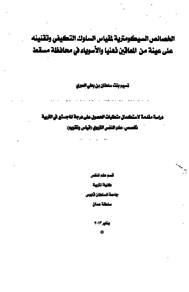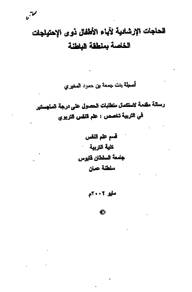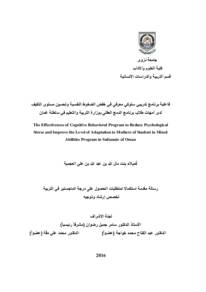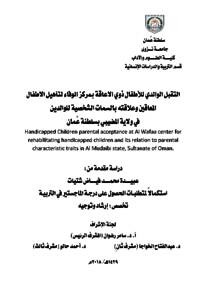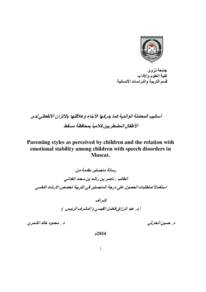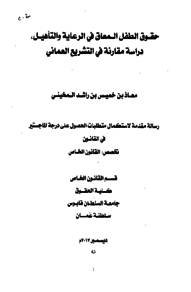وثيقة
الخصائص السيكومترية لمقياس السلوك التكيفي وتقنينه على عينة من المعاقين ذهنيا والأسوياء في محافظة مسقط.
الناشر
جامعة السلطان قابوس
ميلادي
2013
اللغة
العربية
الموضوع
الملخص الإنجليزي
The purpose of this study is to investigate the psychometric properties (validity and reliability) and standardization of the Adaptive Behavior - Scale (AAMR, ABS, S:2)- part One in Muscat governorate. This will provide psychologists and professional with a suitable instrument to measure adaptive behavior when diagnosing individuals with intellectual disabilities. Adaptive Behavior Scale was administered to a sample of (272) students (136= n students with Intellecual disabilities, n= 136 of normal students) and both groups is aged between 8- 13 years old. To estimate the validity of the scale the study used three methods: face validity, criteria- related validity and discrimination validity. To estimate criteria- related validity, the correlation was calculated between the scale and Raven Coloured Progressive Matrices, results showed a statistically significant positive correlation of (r=0.65, p< 0.05). The results showed that the AAMR, ABS was able to differentiate between two groups (students with intellectual disabilities and normal students), and between different age categories. Reliability was estimated by test- retest reliability and internal consistency" Cronbach Alpha". The results showed that the scale has acceptable level of consistency, and stability overtime.
Having established the required psychometrics properties of the scale, the performance norms were derived using percentile ranks because of their ease, clarity, and ability to determine the location of the individual relative to standard group. The norms were derived for the sample (n= 272), and the two groups: students with intellectual disabilities (n=136) and normal students (n= 136) separately, for both male .and female combined. Finally a number of recommendations and suggestions have been introduced
المجموعة
URL المصدر
الملخص العربي
هدفت هذه الدراسة إلى دراسة الخصائص السيكومترية لمقياس السلوك التكيفي للجمعية الأمريكية للإعاقة الذهنية (الجزء الأول - الطبعة الثانية) وتقنينه على عينة من المعاقين ذهنية .. والأسوياء في محافظة مسقط، وذلك لتوفير أداة ملائمة عند تشخيص المعاقين ذهنيا. وقد تألفت عينة الدراسة من فئتين: فئة المعاقين ذهنية المسجلين في مدرسة التربية الفكرية ومدارس الدمج في محافظة مسقط (ن= ۱۳۹)، وعينة من الطلبة الأسوياء في مدارس التعليم الأساسي (ن= ۱۳۶)، وكلا الفئتين في المدى العمري (۱۳۸) عاما من الجنسين من العام الدراسي (۲۰۱۰-۲۰۱۱). وقد تم التحقق من صدق المقياس من خلال ثلاثة إجراءات، هي الصدق الظاهري الذي أشارت نتائجه إلى ملاءمة فقرات المقياس مع البيئة العمانية، والصدق التمييزي حيث كشف النتائج عن قدرة المقياس التمييزية في ضوء متغير العمر بفئاته الست من جهة، وبين المعاقين ذهنية والأسوياء من جهة أخرى، والصدق المرتبط بمحك الذي تم الكشف عنه من خلال حساب معامل الارتباط بين المقياس الحالي ومقياس مصفوفات رافن الملونة، والذي بلغ (۰٫65) وهو ارتباط موجب ومقبول. كما تم التحقق من ثبات المقياس من . خلال طريقتين: ثبات الاستقرار، وثبات ألفا كرونباخ حيث حصل المقياس على (۰٫۹۹) و(۱۰٫۸۹) على التوالي، وهي معاملات اتساق واستقرار مرتفعة ومقبولة. كما تم حساب المؤشرات الإحصائية الوصفية لدرجات أفراد العينة (ن= ۲۷۲) بفئتيها المعاقين ذهنيا، الأسوياء) على المقياس، وبعد أن تحققت الخصائص السيكومترية المقبولة للمقياس تم اشتقاق المعايير الدرجات الخام، واختيرت "الرتب المئينية لتحقيق ذلك، حيث تم اشتقاق معايير موحدة لكلا الجنسين لكل عمر على حدة، اللعينة ككل ولفئة المعاقين ذهنية وفئة الأسوياء بشكل منفصل. وأخيرا تم تقديم عدد من التوصيات والمقترحات بناء على نتائج الدراسة.
قالب العنصر
الرسائل والأطروحات الجامعية

